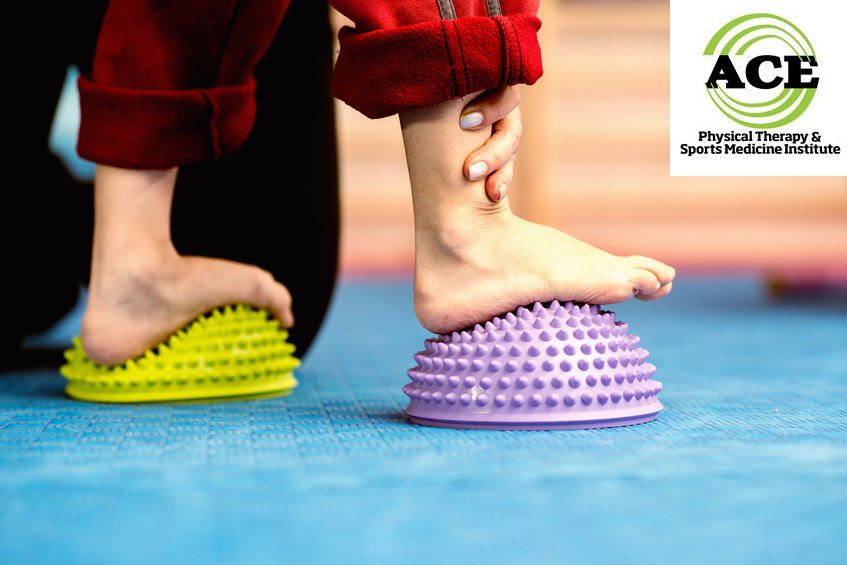FLAT FEET AND TREATMENT IN PHYSICAL THERAPY
 Flat Feet and Treatment in Physical Therapy
Flat Feet and Treatment in Physical Therapy
by ACE Physical Therapy and Sports Medicine Institute
Tid Bits of Info.
- Most custom orthotics need to be made out of a firm plastic or graphite to provide the needed support to an injured foot.
- Strengthening the hip external rotator and extensor muscles is as important as strengthening the ankle muscles.
- Treatment should include using daily ice applications to reduce the inflammation.
- Most cases of PTTD can be treated conservatively and do not require surgery.
- Seek the advice and treatment of an orthopaedic Physical Therapist if you develop ankle or foot pain.
People with flat feet often experience pain in the feet or ankles. The feet may tire easily, and the arches and heels can easily become achy. While some people are born with flat feet, many people become susceptible to flat feet due to an injury, diabetes, obesity, pregnancy, or simply aging. Every single day our feet must bear weight for normal activities. Flat feet can cause ongoing daily pain and interfere with our planned events. Physical Therapy can help address the problem and ease the pain.
Many people suffering from flat feet experience pain that originates from a location up the leg and along the medial side of the shin bone. The pain is intense and can cause them to limp and adjust the way they move which puts extra stress and strain on other body parts. The additional and abnormal stress and strain can lead to injuries to those body partsas well.
One of the most common causes of foot pain is damage and dysfunction of the Posterior Tibialis Tendon (Posterior Tibial Tendon Dysfunction or PTTD). This tendon is located behind the medial malleolus and inserts primarily into the navicular bone. It plays an important role in supporting the medial arch (medial longitudinal arch) of the foot. It has a major role in locomotion and can be injured at any age, but it appears that a gradual onset of pain occurs more in the older population than the young. Children and teens rarely complain of pain in this area of their feet. There are several theories that are stated that try to explain why the Posterior Tibialis Tendon is susceptible to damage but recently it is suggested that vascularization of the tendon decreases with the aging population. Simply stated, the tendon does not get enough blood flow to it to remain healthy. The decrease in blood flow leads to lower oxygen content which can lead to tendon tissue damage and slower healing rates. The pliability of the tendon tissue decreases with age, also.
The onset of PTTD is usually slow and progresses slowly. The acute onset is commonly self-treated with activity modification, rest, NSAIDs, and ice. There is hope that the symptoms will resolve on their own. Unfortunately, the symptoms usually progress to a point that medical attention is sought for a definitive diagnosis and treatment protocol. The patient complains of foot and ankle pain along the medial aspect and sometimes has pain extends up into their shin area. The symptoms worsen with weight bearing activity and quite often force the individual to stop performing weight bearing exercises. It is not uncommon to have a patient that is suffering from PTTD stop performing the activity that they love because the pain in the foot and ankle can be debilitating.
Treatment for this condition usually includes custom made orthotics and a visit to the Physical Therapist. The Physical Therapist will evaluate your symptoms and determine if some of the cause of these symptoms stems from body parts that are not directly associated with the foot/ankle complex. Many times weakness in the core and hip musculature can lead to an increase in lower extremity movement and forces the ankle/foot complex to pronate significantly. This can be combated with a thorough exercise routine that incorporates a strengthening program for the core and entire lower extremity.
Visiting the Physical Therapist is easy and does not require a visit to your doctor. You should seek out a Physical Therapist that specializes in treating orthopaedic conditions. Check with your insurance company because your policy might require you to secure a referral from your primary care physician but not a prescription for therapy.
Flat feet can cause major problems in one’s functional capabilities due to the pain that arises when the “flat” position of the arch is due to soft tissue damage. The damage can be caused traumatically, but as someone gets older the tendon tissue does not get the same amount of blood flow that it received at a younger age. This decreased blood flow is thought to be a major cause of tendon damage in older individuals. Wearing properly supported shoes, performing cardiovascular exercises, maintaining a healthy body weight and strengthening the core and lower extremity musculature are ways to help prevent PTTD from occurring.
Read more articles on our main website blog at: ACE-pt.org/blog
Vist our main website at www.ACE-pt.org

